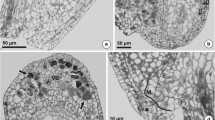Abstract
Megasporogenesis, megagametogenesis and seed formation were analyzed cytologically in populations of Arabis holboellii originating from North America (Colorado) and Greenland. The Colorado population contained only triploid plants, while the Greenland population consisted of diploid and triploid plants. The penetrance of the apomictic trait was assessed at the level of embryo sac development. All populations showed facultative apomeiotic embryo sac development; however the penetrance of this trait differed between the populations. Apomeiotic and meiotic embryo sac development were characterized by diplosporous dyad formation (Taraxacum-type) and meiotic tetrad formation (Polygonum-type), respectively. Flow cytometric analyses of single mature seeds from all three populations suggest that only unreduced gametes participate in viable seed development. Pseudogamy was the predominant mode of endosperm formation; however, autonomous endosperm development was also observed. The fertilization of unreduced egg cells with unreduced pollen was observed at a low frequency in the Greenland populations. The mechanisms of apomictic reproduction in A. holboellii are discussed
Similar content being viewed by others
Author information
Authors and Affiliations
Additional information
Electronic Publication
Rights and permissions
About this article
Cite this article
Naumova, T.N., van der Laak, J., Osadtchiy, J. et al. Reproductive development in apomictic populations of Arabis holboellii (Brassicaceae). Sex Plant Reprod 14, 195–200 (2001). https://doi.org/10.1007/s00497-001-0118-0
Received:
Accepted:
Published:
Issue Date:
DOI: https://doi.org/10.1007/s00497-001-0118-0




